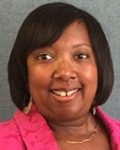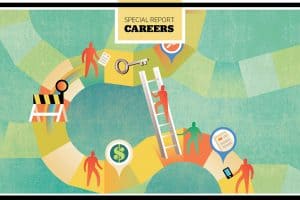
No question: The coronavirus pandemic has warped the educational path for today’s young adults, in turn affecting their readiness for the workforce. In the past, many young people have sought out part-time employment in areas such as the food service industry or seasonal employment, sectors that have been hit hard by the pandemic. These jobs not only provided needed income but also skills training in pursuit of college or career readiness. Now, after more than two years of COVID-19 restrictions and school disruptions, many young adults face the necessity of working to help support their families.
An October 2021 webinar convened by the Public Library Association (PLA) and members of LibsWork, a national networking group focused on workforce and small business development, explored the ways in which libraries can support young people as they enter the workforce amid these ongoing challenges. Librarians and workforce development professionals shared how such programs are helping young people develop essential skills and experience, including work-based learning opportunities, apprenticeships, and more.
Panelists included Kate Aubin, head of youth services at Providence (R.I.) Public Library; Janelle Duray, chief operating officer and executive vice president of Jobs for America’s Graduates; and, representing the Division of Career and College Readiness at the Maryland State Department of Education, Marquita Friday, director of career programs, and Jennifer Griffin, career programs and apprenticeship specialist. The moderators were Larra Clark, deputy director of PLA and the American Library Association’s Public Policy and Advocacy Office, and Lisa Shaw, workforce development specialist for rural and small libraries at Maine State Library in Augusta.
What does the youth workforce look like? How many are unemployed, and how is that measured?

JANELLE DURAY: If we look at the percentages over the past 20 years, we’re seeing youth unemployment at the start of the millennium in the single digits. And that’s good. But then it more than doubled during the Great Recession; young people were hit the hardest in 2008. It took several years for us to get back to those single digits. And then of course, COVID-19 hit, so there was a tremendous spike.
All in all, we’re moving in the right direction but we’re not quite back to the prepandemic levels of 9.1% youth unemployment. Significantly, unemployment rates for Black and Brown youth are higher than what we see among white youth.
But unemployment numbers count only those who are considered part of the labor force—those who want a job and can’t find one. A different number—the labor force participation rate—tells us that many youth are not looking for jobs. Youth unemployment might be at about 10%, but the youth labor force participation rate in July of this year was only 60%, meaning 40% of 16-to-24-year-olds across the country are not employed and are not seeking employment.
What kinds of barriers to employment are young people running into?

LISA SHAW: In a recent survey we were involved with, which had more than 200 young people responding, those who were working were asked what sorts of barriers they were encountering. In some cases, they said no barriers. But there were a lot who did indicate some barriers.
For many respondents, lack of transportation was huge, especially in rural areas where there’s no public transportation to speak of. Young people are afraid of taking on debt for higher education or for transportation or housing. They see their parents still paying off student loans or car payments.
Not understanding what skills were needed for a particular job—or not having skills they think are needed—is another barrier. Lack of technology, whether it’s broadband connectivity or even cell service, or a lack of equipment in the home, was another obstacle. Some also mentioned social anxiety with regard to in-person interactions as a problem for them.
DURAY: Supporting young people is not just about connecting them to jobs. You have to focus on the whole human and reach them where they are, understand what challenges they may have that prevent them from securing employment, and start there. And if you take this learner-engaged, wraparound-services approach, which I think public libraries do, adding and engaging other community partners, you will see successful outcomes.
How do you plan workforce readiness programs with youth rather than for youth?

KATE AUBIN: About six years ago, Providence Public Library applied for an Institute of Museum and Library Services leadership grant. Prior to that we had no real teen program to speak of. In doing research and running focus groups, we saw how important it was for youth to get paid and learn workforce skills at the same time. So we developed Teen Squads—driven by youth interests—to focus on work readiness, development of 21st-century skills, and connected learning opportunities.
One of our biggest goals was to talk a lot about people skills—those soft skills that employers consistently say people coming into the workforce lack. Candidates might have strong hard skills but lack in areas like teamwork, communication, critical thinking, perseverance, and engagement in their own learning. So we make sure to embed these in all of our programs. We also have a content instructor that focuses on hard, industry-specific skills.
Another goal we have for our teen programs is that they provide work exposure. We have guest speakers who talk about different industries that they come from, and about how there’s no one way to get onto a specific career path. They talk about their backgrounds and what skills they use in the workplace. We try to make sure these guest speakers look like the youth in our program—we serve a lot of youth of color. We want them to see these are opportunities they can pursue themselves.
All of our programs require a big investment of time, especially the Teen Squad programs and our summer employment programs, so they involve either a stipend or a paycheck. Offering youth wages for their time and for the work they put in is important.
At the end of every Teen Squad program, the young people present their final projects to the community and their friends, peers, and library staffers. They get the pride of showing off their work and being able to explain it to others, and they also get to practice presentation and public-speaking skills.
How helpful are career and technical education (CTE) programs?

MARQUITA FRIDAY: They have come a long way over the years. And currently, at least at the Maryland State Department of Education, when we think about CTE, we think about opportunities that will really engage students. We want to make sure our programs are aligned to high-skill, high-wage, high-demand careers. We want students to be able to earn an industry-recognized credential or a postsecondary credential that will allow for advancement in a specific career cluster. We’re looking for opportunities that will lead students into careers that will give them a sustainable, family-supporting, livable wage.
A number of years ago, we developed a CTE library project in which we partnered with local school systems and their nearby public libraries. The point was to be able to bring awareness and knowledge about CTE to parents, to other people within the school systems, to policymakers, and to the broader communities.
We gave small grants to school systems. Funds could be used to create posters about CTE to put into public libraries, for example. And there was always a kickoff event that would include the state superintendent of schools, people from the local chamber of commerce, and people from the local libraries. CTE students had the opportunity to talk about what they were able to do with their CTE program of choice, whether they were still in high school or recently graduated. If they were a recent graduate, they talked about how their CTE program helped shape their plans. We did nine of these events, which means that we hit over a third of our school districts.
What about apprenticeship programs?

JENNIFER GRIFFIN: Apprenticeship Maryland is a program that we started in 2015. After the two-year pilot, we saw that it needed to continue, so we made it a CTE program, meaning students can use it to meet graduation requirements. We are thrilled about that. We started by writing a program of study and gave it out to all our school systems. They can decide if they want to participate or not. Once they fill out the paperwork and it’s approved, they can start it. And I’m very happy to say that out of the 24 local school systems in Maryland, 20 are currently offering it.
Basically, the program allows students to start doing a youth apprenticeship while in high school. It’s available for students who are at least 16 years old, juniors or seniors. There’s a lot of flexibility: Students can start as early as the beginning of their junior year or even the summer before, if they’re 16. They continue working until they graduate. The best part about this is that they are paid by the employer and that it is at least minimum wage. The program also includes related instruction that is dictated by the business.
One company that came on board during the pilot, an autobody company in Frederick County, had the same problem as everybody else in the United States: They couldn’t find workers, so they decided to become a youth employer. They did the paperwork and were approved by the school system, and it is five or six years now since the program was implemented. The school system now is the only pipeline they use to hire employees.
They usually have 10 or 12 students who apply for one or two positions every year. Once those students graduate from high school, they can continue working for the next few years as an adult apprentice, and the company pays them to get a two-year degree at the local community college. It’s a win-win.
FRIDAY: There are many ways for public libraries to partner with local school systems and community colleges to provide CTE information. If there is an apprenticeship coordinator in your state, for example, you can invite that person to come to the library to talk about opportunities for young people. That’s a good way to find out what workforce development initiatives are happening in your state.
If you’re having people from the school system or a community college coming into the library for employment information sessions, you want to time it appropriately. When we did the CTE library project, for instance, the sessions always happened in November, December, and January because at the secondary level, students start signing up for classes in January. We wanted to put the event close to the time students were signing up.
What steps can libraries take to enhance youth workforce readiness, even if they’re stretched and funds are limited?
AUBIN: We all know from working in libraries that capacity is limited. There’s so much to do and so little time and so few people to do it. The way we approach partnerships is we make sure we’re at the table. We go to a lot of different meetings even if it feels like maybe that’s a weird place for a library to be. We see what people are doing and how it might connect to what we want to do. It takes a lot of time to get people to think of the library as not just a place for books. But once they see all our assets, it becomes a clear, no-brainer partnership.
Partners can run workshops and give feedback on projects. They do tours of their workplaces and talk about career paths. Using partners takes some of the work off our hands and exposes us to other adults in the community. We reach out to our library staff and board members to find partners. Everyone has great networks and it’s foolish not to use them. Find out who else in your community is already doing this work and assess possible resources. You might find someone who wants to partner with you so you aren’t responsible for the whole load of it. If you have some space but don’t have money, maybe find someone who has money but needs space. See what needs you can help each other meet.
We’re lucky to have leadership that believes in what we’re doing and supports us to make things happen. If you’re going to do this work, you need to make a case for it to your supervisors, administration, and board. Once they see the value, it can change everything.
It’s hard work, I’m not going to lie. It took us a lot of time and effort to get where we are. But the youth who have come out of our programs are always asking us, “What’s next? What can we do? What new program are you going to offer? How can we stay involved?” It really is about building relationships with young people so that they see the library as a place for them.


